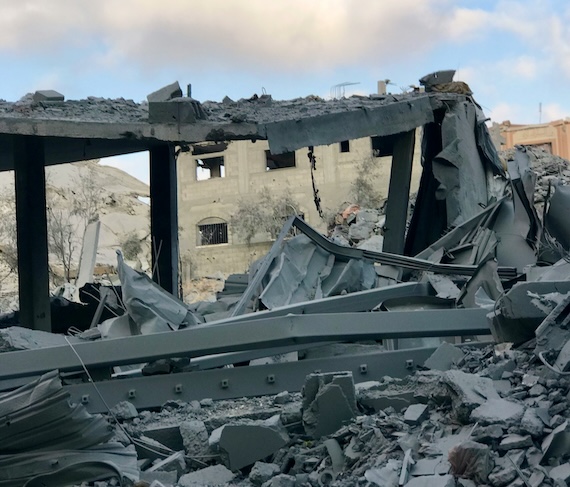Trump’s peace plan includes a promise not to expel any Palestinians from Gaza. Can’t that promise be kept?
( Foreign Policy in Focus ) – Amid some extremely cautious optimism for peace following a tenuous and incomplete ceasefire in Gaza, any hope for Gaza’s future depends significantly on a little-noticed point in President Donald Trump’s original 20-point peace plan.
The plan’s twelfth point says, “No one will be forced to leave Gaza, and those who wish to leave will be free to do so and free to return.” The plan goes even further, saying, “We will encourage people to stay and offer them the opportunity to build a better Gaza.”
Although there are reasons to doubt many elements of the Trump “peace plan”—which neither side has agreed to in full—the assertion that no one will be forced to leave Gaza represents a major reversal: prior Israeli and U.S. government policy clearly aimed to force some or all Palestinians from the Strip.
Indeed, Trump’s previous plan to turn Gaza into the “Riviera of the Middle East” involved displacing Palestinians outside the Strip. Last March, Prime Minister Benjamin Netanyahu stated his support for the “realization of the Trump plan” and what some Israeli and U.S. leaders euphemistically called “voluntary migration.”
“This is the plan. We are not hiding it,” Netanyahu said. That same month, the Israeli cabinet approved the creation of a so-called Voluntary Emigration Bureau charged with moving Palestinians out of Gaza and to other countries such as Libya, Indonesia, and the Republic of the Congo.
The mass expulsion of Palestinians by the Israeli government has been a major feature of the last two years of violence following the October 7, 2023 attacks by Hamas and allied forces, which resulted in the deaths of around 1,200 Israelis and foreigners. In a new report published by Brown University’s Costs of War Project, I compiled the best available international data to document how the Israeli military has displaced almost everyone in Gaza over the past two years: 2,026,636 people or around 92 percent of the Strip’s pre-war population. Many have been displaced multiple times: on average, three to four times for every displaced person. Around 45 percent of the displaced have been kids.
The displacement has extended to the West Bank, where some Israeli leaders have also supported ethnic cleansing. In the last two years, 43,624 Palestinians in the West Bank and East Jerusalem have been displaced from their homes by the Israeli military and police forces, government-backed Israeli settlers, Israeli government demolition orders, and other violent causes. Broader Israeli and U.S. wars in the region have displaced an additional 3.2 million people in Iran, Lebanon, and Israel itself, as well as what are likely thousands more in Yemen and Syria.
According to numerous experts, the mass displacement of Palestinians—nearly 12,000 per day on average in Gaza alone—constitutes the war crime of “forcible transfer,” which is a crime against humanity under international law. Senators Chris Van Hollen and Jeff Merkley concluded in a September 2025 report that “the facts demonstrated overwhelmingly” that Israel was “implementing a plan to ethnically cleanse Gaza of Palestinians and dealing a death blow to the vision of a future Palestinian state that would include Gaza and the West Bank.” Any implementation of the original Trump plan to displace Palestinians to other countries would constitute further war crimes and ethnic cleansing. It would also continue a pattern of ethnic cleansing dating to the founding of the Israeli state in 1948 and Israeli military forces’ expulsion of more than 700,000 Palestinians in what Palestinians call the Nakba—the catastrophe.
The lives of millions of Palestinians in Gaza and the West Bank, and ultimately the lives of millions of Israelis, hang in the balance as the world waits to see if Netanyahu’s government abides by the current ceasefire and commits to a full end to its war or if it re-commences its assault and genocide as it has in prior ceasefires.
Since the announcement of a deal last week, thousands of displaced Palestinians have filled roads walking in search of their homes in a vast landscape of grey rubble. The sight of people trying to return home amid such destruction offers a glimmer of hope while reflecting the immensity of the challenges ahead.
“I’m going to Gaza City even though there are no conditions for life there—no infrastructure, no fresh water,” one of the displaced, Naim Irheem, insisted to one of the few news outlets reporting from Gaza. “Everything is extremely difficult, truly difficult, but we must go back. My son was killed, all my daughters were wounded. Still, I want to return. We’ll pitch a tent and live in it, however it can be done.”
Ending the displacement of Palestinians as well as the mass killing and destruction of Gaza’s infrastructure are clear requirements for anything approaching peace. Israeli and U.S. leaders must commit to the Trump peace plan’s promise that no one will be expelled from Gaza.

Photo of Gaza July 21, 2024 by Emad El Byed on Unsplash
This promise—and the entire peace process—may prove to be yet another cynical ruse, much like the Israeli government calling past expulsion “voluntary migration.” For now, supporters of peace must work to ensure that no one will be forced to leave Gaza, that the displaced can return home as international law requires, and that they receive aid and reparations for their displacement.
These must be among the first steps toward real peace and justice that will require holding perpetrators accountable for their crimes and addressing Palestinians’ rightful demands to return to homes from which they were displaced beginning in 1948.
David Vine is a political anthropologist and contributor to the Costs of War Project.


 © 2025 All Rights Reserved
© 2025 All Rights Reserved